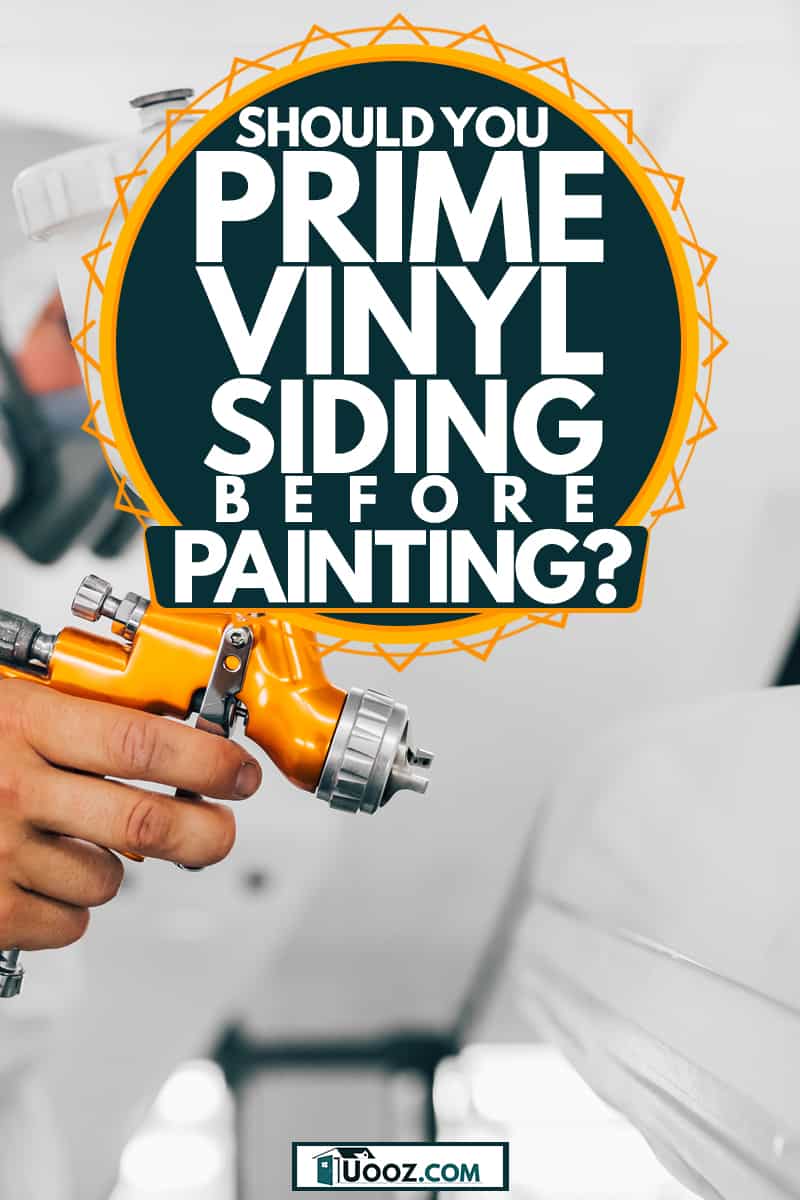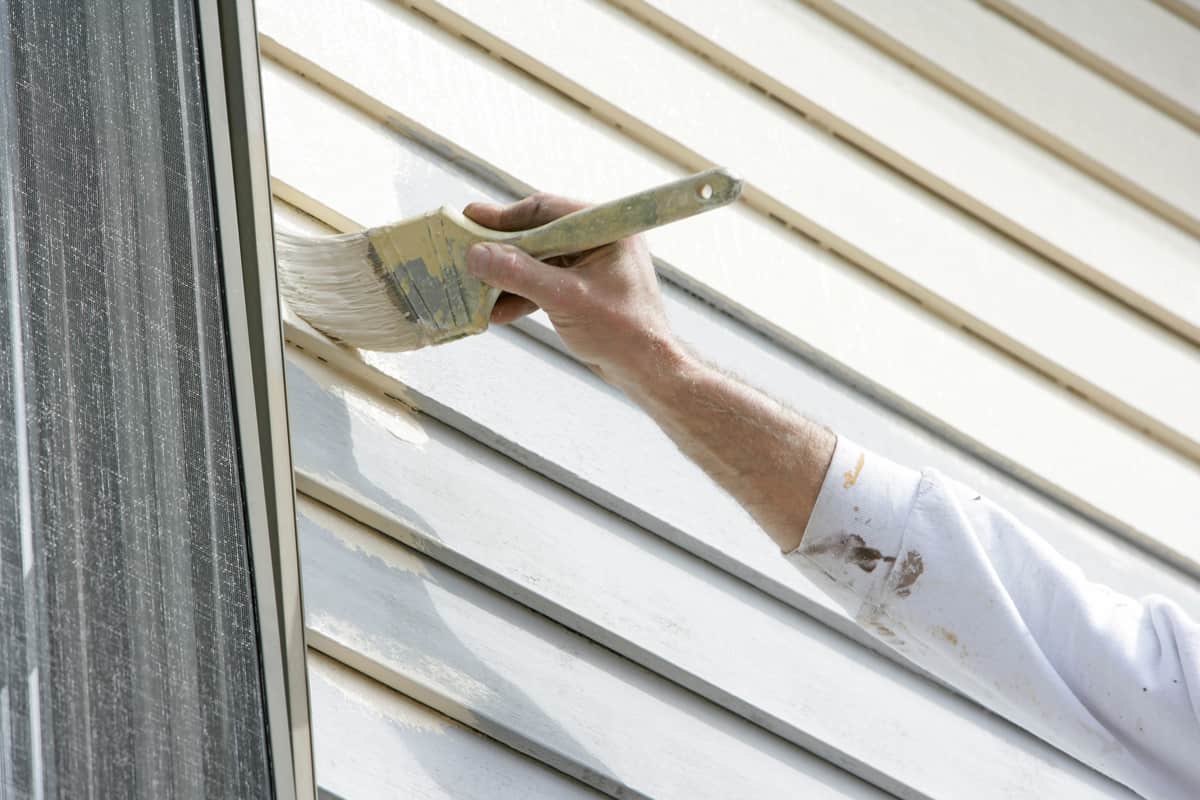Most paint jobs require the use of a primer before painting. Primer allows for the paint to go on smoothly and without blemish. When painting vinyl siding, you might be wondering if you need to prime it. We've done the research to bring you the answer.
As long as the vinyl surface has had time to weather (at least a year), it should be ready to take paint. No primer is needed except in cases of a very damaged vinyl surface. The surface needs to be well cleaned, with all residue and debris removed, before painting.
In this article, you'll learn about the specific situations you will need to use primer, what kind of paint you should use, how to prep your vinyl siding, and the questions you should ask yourself before committing to painting vinyl siding. Just keep reading!

When You Should Prime Vinyl Siding
A primer will only be needed if:
- The surface of the vinyl is so worn that it is showing marks such as pitting.
- The original color has faded away and is completely removed.
- The vinyl has become porous.
If a primer is needed, use one made specifically for vinyl siding, such as this latex primer by KILZ. Vinyl siding is more flexible than most surfaces, and requires the correct primer and paint to adhere correctly.
Click here to see KILZ Adhesion High-Bonding Latex Primer on Amazon.
How Do You Prepare Vinyl Siding For Paint?
Paint your siding on a temperate day. The ideal time to paint is in weather that is overcast but dry. Any amount of rain can ruin your paint job. Conditions that are too hot, humid, or windy may also provide less than desirable results.
Vinyl siding needs to be cleaned with a soft cloth or a soft bristle brush and a cleaning and degreasing product made for vinyl such as Scotts outdoor cleaner.
Click here to see Scotts outdoor cleaner on Amazon.
Cleaning well is one of the most important tasks to end up with a satisfactory paint job. If the siding is not clean, the paint will not adhere properly. This will lead to cracking and peeling of the paint.
Once cleaned, check over the siding to make any final repairs needed before painting, such as filling small holes or replacing missing nails. You can use these self-adhesive Mendyl vinyl siding repair patches to fix small problem areas in your siding.
Click here to see the Mendyl vinyl siding repair kit on Amazon.
The final prep step is to tape off any areas where you do not want the paint to touch, such as around doors and windows.
What Kind Of Paint Will Stick To Vinyl?
Use a vinyl-safe latex urethane paint. Like vinyl-safe primer, this kind of paint is formulated to be able to flex with the movement of vinyl as it expands and contracts in changing weather.
Just like other house paints, the paint you select will come in flat, satin, or gloss finish. Satin is recommended as it is most similar to the finish of typical vinyl siding. A good choice is Rust-oleum Exterior Mildew Performance Paint in satin. It can be tinted to suit your color scheme.
Click here to see this product on Amazon.
What Color Paint Should You Pick?
For best results, pick a color similar to the original siding. When in doubt, go lighter than the original siding rather than darker.
It is necessary to avoid dark colors, as they hold in heat. This can potentially cause the vinyl siding to warp. Your vinyl is made to withstand the demands of nature for the original color it was manufactured in, but it may not be durable enough once you cover it in a darker shade.
The best paint colors have a high light reflective value, or LRV. This is a number from 0-100 listed in the small print on most paint cans. The higher the number, the less heat it holds, and the less risk of warping (avoid anything lower than 55).
Do You Brush Or Spray To Paint Vinyl Siding?

You can use either one. Unless you have a lot of experience with a sprayer, it can be difficult to avoid drips. Many people prefer the brush method. However, it's worth noting that a sprayer used with skill gives results most similar to the way vinyl siding looks from the factory. Ultimately, it is best to choose the method you feel most comfortable with.
The most important thing, whether you choose a brush or spray, is to be sure to paint under the seams of the siding. When vinyl contracts in cold weather, this will prevent visible gaps where the paint is missing. Aim to cover 1 inch under the seams, as vinyl can regularly expand and contract 1/2 inch in typical seasonal changes (and sometimes more!)
Is It A Bad Idea To Paint Vinyl Siding?
Painted vinyl siding can last as long as 10 years if done properly. It is important to note that paint is not as durable as the vinyl itself. Once it has been painted, it will become more prone to fading and chipping. It will require repainting, and some estimates say that can be as much as every 5 years.
If the maintenance doesn't scare you, there are some additional drawbacks:
Voided Warranty
If your siding is covered by a warranty, it will probably not be honored after it has been painted. This is typically considered as voiding the warranty.
No Change In Condition
Painting is mostly an aesthetic improvement. If your siding is in bad shape, you may need to replace it instead.
No Chance To Make Improvements Or Corrections
Vinyl siding lasts for a long time, and during that time, undetected damage from pests, moisture, or other sources may be occurring. Taking off the vinyl to replace it offers you a chance to see the condition of everything under the siding and assess if any work should be done. It also gives the opportunity to make improvements in insulation.
However, in some situations, painting may be the right decision for the homeowner. Improvements in paint formulas in recent years make painting over siding a very reasonable goal nowadays (whereas in the past, no paint could flex with the movement of vinyl siding). You will have to consider the pros and cons and decide if painting your siding is the right choice for you.
Should You Hire A Painter Or Do It Yourself?
Painting vinyl siding is no small feat. It is a large, labor-intensive project that requires extensive and careful prep work. You have to be able to paint carefully under seams, up high on a ladder, and in potentially changing outside weather - and you have to be able to do all that while leaving a smooth, even coat of paint!
If you aren't a particularly skilled painter, this one may be best left to a professional. A professional will also be able to perform the job in less time than an amateur and be less expensive than replacing vinyl.
In Closing
Modern paint formulas have improved in flexibility and durability. Painting vinyl siding is now an option for homeowners who want to freshen the look of their siding without replacing it altogether. Most situations will not require a primer, just urethane paint that is marked as vinyl-safe. Cleaning vinyl thoroughly is an important step to ensure good results for your final project.
Before you go, be sure to check out these other helpful home improvement guides:




